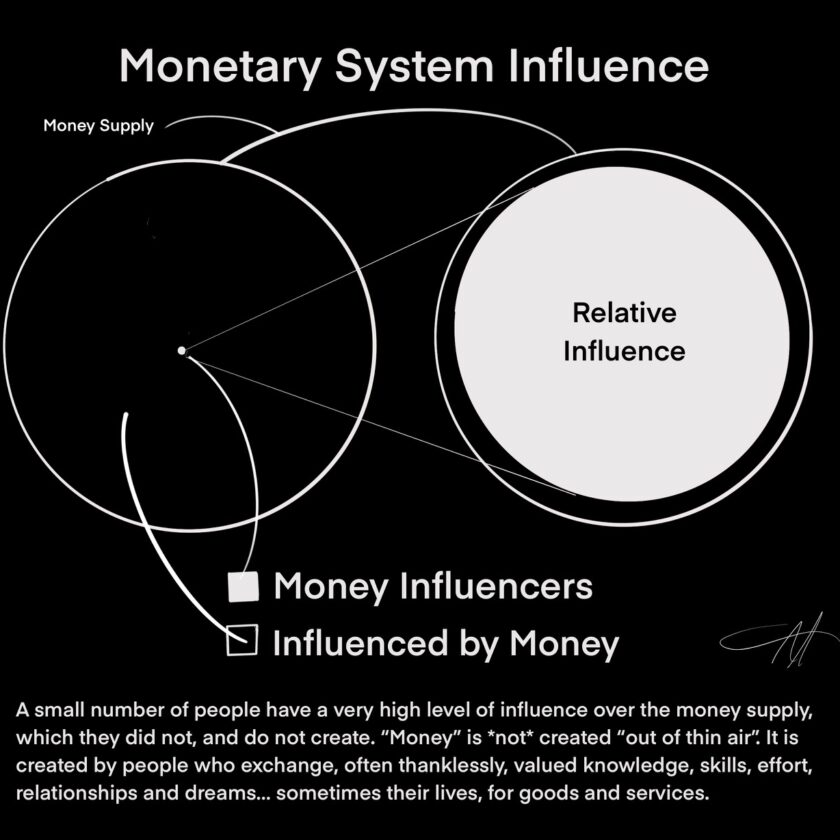
It rarely crosses our mind, but it should be noted that what we refer to as “the healthcare industry” is a collection of money-driven business entities. Just that statement alone gives reason to pause, because it includes both “for profit” and “not-for-profit” organizations. The not-for-profits can lay claim to some noble purpose, but they are still very much for the money. “Dead president promissory notes” remain their chief deity.
Health, on the other hand, is a province and state of living beings. Holding the word “health” in common with the collective of corporate entities that is the healthcare system doesn’t mean that its methods, standards, and practices are intended to help maintain or restore the human state of health. Business health is not measured in quality of life, but quantity of dollars relative to costs. Quality of life and health, are non-factors. Instead, the appearance of life and movement toward health, are prime.
When money is the chief focus, health may result from one’s activities. However, when a person becomes ill, health is likely to return faster if nature and balance are allowed to take its course. As such, an undeclared War on Nature has been raging all around us and against us for several generations that we have all but failed to notice. The healthcare industry is so into “the war,” they’ve all but ignored the restorative power of balance.
I am not against money. There should be a fair exchange and mutual benefit when energies are engaged, either as producers or consumers. However, objectives must also be singular and clear. When a person gets sick and seeks the knowledge and services of a doctor, the patient’s objective is to restore the state of health. The doctor may want to do likewise, however, the guidance indicated by his education, professional association, and industry, actually interfere with health’s restoration, or make the disease condition worse.
An Unholy ‘Dance’ with Vaccines

To see such policies in action, we need only look at how vaccines are now routinely given to people for diseases they’ve not had, particularly children, on the presumption that they’ll get it. Then when some people do demonstrate the pathology, medical officials tell themselves (and us) that they need to inoculate more people, never questioning whether the chemicals in the vaccines had anything to do with the disease’s onset.
Vaccine pushers carefully word their press releases, advising consumers that there is still no guarantee that they won’t contract the condition that the vaccine is designed to “protect” against. Yet, in addition to not getting your money back, many people lose their health and never get it back. If the patient objects, practitioners are quick to question, or even challenge an individual’s judgment, particularly parents for their children, if they have the audacity to say “no, thank you” to the doctor’s kind protection offer.
If you take current vaccine thinking to its present “logical” conclusion, there would be a vaccine for every disease known to man. Why? Because diseases are idea constructs that are created by money-driven men. “Restless leg syndrome” is an example of such an idea construct. They are mutual thinking points, morphic fields that are used by all parties to the condition.
The perfect money-maker in the medical world would be to have “approved” medications for every known disease. It would even be more perfect to force the public into “patienthood” by way of policies, statutes, and laws, to involuntarily take the medications without ever having the disease, and then claim credit for preventing them.
If some people get the diseases anyway, such as for HPV, for which Gardasil® was developed, the industry and its practitioners are still protected because they told us it wasn’t a guarantee, The spate of new diseases that evolve are viewed as reason to initiate new money-raising and research activities. They are not presumed to have anything to do with the existing medications that have become part of “normal” business.
 The money motive is always present, but never admitted to, especially by $cientific researchers. This was very obvious in A Conspiracy of Cells: One Woman’s Immortal Legacy and the Medical Scandal it Caused, by Michael Gold (1986 SUNY Press). The book chronicles the discovery that some mysterious agent was changing the identity of human cell line specimens that are used — bought and sold — by the cancer research community. A prostate cancer research scientist needs “live” human prostate cancer specimens in order to observe and determine what the new drug she’s developing will do. In order for her research findings to be considered valid — according to scientific method — the specimens must be representative of the target tissue. In other words, findings made on a prostate cancer drug must be done on prostate cancer cell cultures. The value of the researcher’s findings would be lost if it turned out that the tissue samples she worked on were from lung cancer tumors.
The money motive is always present, but never admitted to, especially by $cientific researchers. This was very obvious in A Conspiracy of Cells: One Woman’s Immortal Legacy and the Medical Scandal it Caused, by Michael Gold (1986 SUNY Press). The book chronicles the discovery that some mysterious agent was changing the identity of human cell line specimens that are used — bought and sold — by the cancer research community. A prostate cancer research scientist needs “live” human prostate cancer specimens in order to observe and determine what the new drug she’s developing will do. In order for her research findings to be considered valid — according to scientific method — the specimens must be representative of the target tissue. In other words, findings made on a prostate cancer drug must be done on prostate cancer cell cultures. The value of the researcher’s findings would be lost if it turned out that the tissue samples she worked on were from lung cancer tumors.
It turns out that this is the kind of “identify change” that the HeLa cell was and is causing, in addition to adding race and gender markers that were associated with Henrietta Lacks, the woman whose cervical cancer tumor specimen is associated with the first discovery of the HeLa… or so the story presently goes.
My point in all this is that the discovery of HeLa contamination didn’t result in a unanimous, conscientious push by medical researchers to remove any question of specimen integrity. Instead, they were annoyed at Walter Nelson-Rees for bringing the matter to the profession’s attention and calling for stricter tissue integrity protection methods.
Over thirty years after the original problem was discovered, which had been at least twenty years after the HeLa cell had been introduced, the problem yet exists today. (See linked article.) If healing were the true objective of the researchers, then it would have been important to ensure that the specimens they used were right. But when it’s about money, or professional stature, which is still about the ability to charge money, then it’s another story. It’s the story that we have today.
Political types have cultivated the mindset that the healthcare system should “protect” every citizen, to the extent that legislation has been enacted that seeks to coerce, or even force the individual into the healthcare system, so as to “pay their fair share.” Note the money dominance in the thinking. However, the healthcare system’s Prime Directive is unchanged. We must still show them the money! And a lot of it! They don’t have to show us the health, and they’re not. We’re so used to them not showing us the health, we’ve stopped looking for it, with their encouragement.
Since we don’t think of these things that often, what with the NFL football season, American Idol, House, and Big Brother all gearing up once again, it is useful to consider that the Healthcare Industry needs us more than we need it. Even more so, it needs us to be sick. Sickness is good for the healthcare business.
Current healthcare practices have, for over 300 years, been guided by the money motive. This includes the materials and procedures that were selected. The decision, which goes back to Edward Jenner in the early 1800’s, to suggest that cowpox could be used as a plausible substitute for human smallpox made it more practical to offer smallpox response in a money-making organization. Using cowpox made it possible to actually stock up on raw material to produce the vaccines. Human smallpox was only available when people had smallpox. Not nearly as reliable a resource, business-wise.

Eighteen pence was established as the minimum that a vaccination officer would charge for the procedure in 19th Century London. Scaring the skin was a visible way to distinguish who had, and had not received the treatment, and more importantly, who had paid the price. All of this was instituted because the ability to make money was present, even though the method did not, in truth, eradicate smallpox, as had been speculated.
As a society, we remain more concerned about money than we are about the state of health of our bodies, and of our relationships with others. We continue to judge and compare others, as well as ourselves, by “what we have” versus what exists in our heart. Why? Perhaps because the heart can’t be regulated, nor can anyone else be an “expert” over what drives it, and as a result, what drives you.
Therefore, it is deemed better to set aside the heart and get your money affairs and values in order, which generally involves setting common sense, conscience, and even our humanity aside. What we get in exchange is insanity, heartlessness, and inhumanity, presented in white coats and three-piece suits.
Better than condemn the system for being the great evil force in our world, how about simply realizing how it was done; that is, by lateral power transfer, from many to a few. Each who walks his path in self-harmony, increases his own health and reduces the potential of harm, both within the body and beyond.
There’s no better time in history to live by these precepts, than now.





Hi there, This isn’t about the post below but having just read Jim Humble’s recent post on the nutritional damage being caused by not eating meat, I wonder where you stand on such an important issue? I have been a vegetarian most of my life and now only occasionally eat fish. I know i could be healthier and have greater energy but I really baulk at the idea of eating red meat and bacon. In short, is the consumption of meat, in your opinion, necessary in oreder to maintain peak health? I find myself troubled by this issue now.
With thanks, Sara Macdonald
Sara
________________________________
Hi Sara,
The human body was designed to process and synthesize its nutrients from sources that are most like it, vibrationally and energetically speaking. Animal proteins are included on that list. The problem is not with eating meat. Instead, it’s with what is done to most meats in its growth and processing. The effects of hormones, antibiotics, genetically modified ingredients in feeds, and other synthetic agents, make it possible to squeeze more profits out of the animal business — or so the industry thinks — but the consumer experiences the consequences with compromised health.
Limiting one’s diet to “organic” foods is no walk in the park either, because commercial processing thinking and technology has impacted it too. The water that crops are grown in is often contaminated, chemically treated, and highly entropic energetically (disruptive). They are often irradiated to extend their shelf life after harvesting, and are actually deficient in nutrient value in spite of being more costly to purchase. Unless one is growing their own foods and fruits and taking them off the vine, this makes predominant or exclusive dependence on vegetarian diets equally problematic to health, if not more so. With meats, particularly when they are free of chemicals, antibiotics, and synthetic hormones, it is actually easier for the body to assimilate its proteins and enzymes that they contain.
A great book to read on this subject is Electrical Nutrition, by Denie and Shelley Hiestand.
Best wishes and health,
Adam…
I think the philosophy of all or nothing, true or false, money or grace is a little restrictive. Sometimes reality walks on the middle ground.
Health care is like a stubborn donkey. You don’t give up the reins and let it do what it likes, you get out the carrot (some money for doing the right thing), and the stick (less money for doing the wrong thing) and then watch it pull the load!
The cost of vaccinations is almost always less than the cost or pain from the disease. Pneumonia, small pox, tetanus (lock jaw), and shingles are good examples. God helps those who help themselves — if you can prevent it, do it.
To me this is a matter of objectives and priorities. When we get sick, we want to get well and return to life. However, the predominant medical system’s first priority is ITS OWN fiscal health, not human health. It does not measure its performance by how well it helps people stay healthy, or how quickly it helps people restore health. Instead, it SELLS the public on disease, and INVITES them to ask their doctor if certain remedies are “right”; never mind that you may experience dizziness, hallucinations, have thoughts of suicide, inflammation, or any number of other “side effects.”
I believe it is better to eat the carrot than dangle it. However, it should have nutrition in it, which many do not, due to standard chemical use in growing practices. This is a large part of our problem. The reasons for disease come from many directions. Yet, they appear singular in intent. The money should be given to those who help us achieve our goal; i.e., restore health from sickness. Unfortunately, people who have succeeded at that have found themselves harassed, marginalized, or prosecuted by the Medical Autocracy, or taken out of the picture in other ways.
We are paying costs of vaccinations in ways that few have seen, as they have been more useful for the BUSINESS of medicine than they have for HEALTH of humanity. We’ve grown accustomed to vaccinations, and bought the story that they prevented smallpox and polio. As such, we’ve given them a pass for anything and EVERYTHING that medical $cientists put in them, and they are putting A LOT in them that are doing real harm. Yet, we think that the new diseases that have cropped up in the past 50 years, along with the escalation of many older ones, are simply reasons to develop and FORCE more vaccines on the population… “for their own good.”
It’s all right in front of us if we’re willing to look at it clearly.
http://shiftfrequency.com/grazyna-fosar-franz-bludorf-the-biological-chip-in-our-cells/